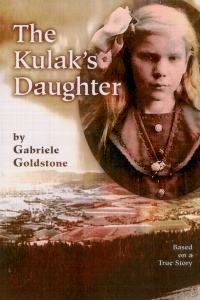| ________________
CM . . . . Volume XVI Number 29. . . .April 2, 2010. 
 |
The Kulak�s Daughter.
Gabriele Goldstone.
Austin, TX: Tire Swing Books/Blooming Tree Press (Distributed in Canada by NBN, National Book Network www.nbnbooks.com/NBNCanada/), 2009.
201 pp., pbk., $8.95.
ISBN 978-1-93-383114-5.
Grades 6-9 / Ages 11-14.
Review by Daphne Hamilton-Nagorsen.
***/4
|
| |
|

excerpt:
Mama moans softly in her sleep. Sofie and Marthe are huddled together at her feet. I tiptoe around them and quietly go through all of Mama�s belongings stashed under her head after shooing away a couple of rats.
There�s a photograph in Mama�s bag. It�s hard to see properly, but I can tell it�s of our family. Little Emil sits on Mama�s lap. His round eyes smile out of a plump, happy face. I admire my own clean clothes and my shiny, brushed hair. Albert stands straight and proud. Sofie and Marthe look pretty with ribbons in their neat hair. But Mama�s face is full of worry. She doesn�t like getting her photo taken. Maybe she can already see into the future, just like I can look into this image of the past.
Studying the faces again, I realize we all look worried. This photo had been taken after Papa�s first arrest. It�s like we�re looking forward and none of us like what we see. And now, here I am, looking backward at something that is gone.
Twelve-year-old Olga has a good life on her family farm in the village of Federofka. This changes as Stalin moves toward the creation of the collectives, branding the individual farmers as kulaks. Olga�s father resists Stalin�s ideas. As a result, Olga�s father is arrested, beaten, released, re-arrested and labelled a first-class kulak. Olga and the rest of her immediate family are labelled as second-class kulaks and forced to leave their farm. They are sent to the Tomsk transition camp, also known as Yaya, where the family must try to survive.
The Kulak�s Daughter is an absorbing account of what happened to the farming families under Stalin. Gabriele Goldstone tells the story of one girl and her family in the early 1930s when Stalin first began to arrest kulaks, move them to work camps and take their land for collective farms. The story is based on the life of Gabriele Goldstone�s mother. The picture described in the excerpt is reproduced on the back cover of the book.
Gabriele Goldstone has taken a complex and difficult time period and effectively brought it to life for young readers. Goldstone has created an interesting and emotional story which is firmly set in the time and geography of the actual events. The atmosphere that has been created clearly brings the emotion of the story and the characters through to the reader without avoiding the more difficult events of the story.
The time frame covered in The Kulak's Daughter is important as it shows the early period of Stalin's campaigns against the kulaks. From the contents of the epilogue, it is clear that Olga and her family faced much more hardship than is covered in The Kulak�s Daughter, but Goldstone wisely limited the scope of this book to the events of 1929 to 1931. Limiting the time frame allows Goldstone to provide a much more thorough story, leading the reader through Olga�s life on an intimate basis. In so doing, Goldstone provides the reader with a much greater sense of what Olga and her family experienced and provides a deeper connection between the reader and Olga.
The Kulak�s Daughter is narrated by Olga, which is a very effective technique for this type of story. Goldstone has not avoided the more difficult aspects of the story of the kulaks in the early 1930s. The impact of families being torn apart, forced from their land, along with death and fear of the future, are all covered through Olga�s eyes. The lack of an omniscient narrator makes the reader experience things when and how Olga does, without really any knowledge of what the future holds for Olga and her family. This approach gives the story a much greater impact on the reader and certainly creates a lasting impression.
The Kulak�s Daughter is a moving portrayal of a family trying to survive in Stalin�s Soviet Union in the early 1930s. Although it is fiction, it is well grounded in the actual events of the time and gives a strong and emotion look at what happened to the kulaks and their families.
Recommended.
Daphne Hamilton-Nagorsen is a graduate of the School of Library, Archival and Information Studies at the University of British Columbia, Vancouver, BC.

To comment on this title or this review, send mail to
cm@umanitoba.ca.
Copyright © the Manitoba Library Association. Reproduction for personal use is permitted only if this copyright notice is maintained. Any other reproduction is prohibited without permission.
NEXT REVIEW |
TABLE OF CONTENTS FOR THIS ISSUE- April 2, 2010.
AUTHORS |
TITLES |
MEDIA REVIEWS |
PROFILES |
BACK ISSUES |
SEARCH |
CMARCHIVE |
HOME |
